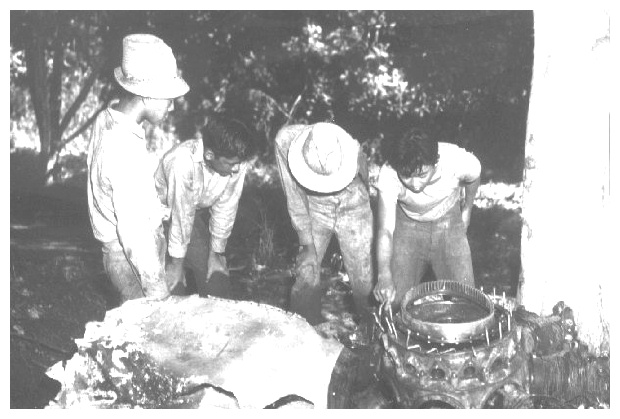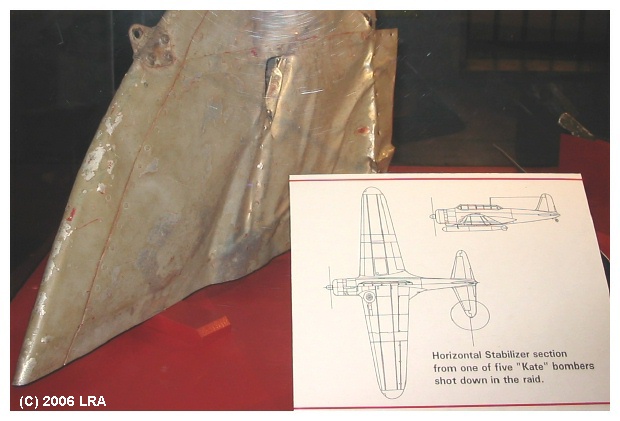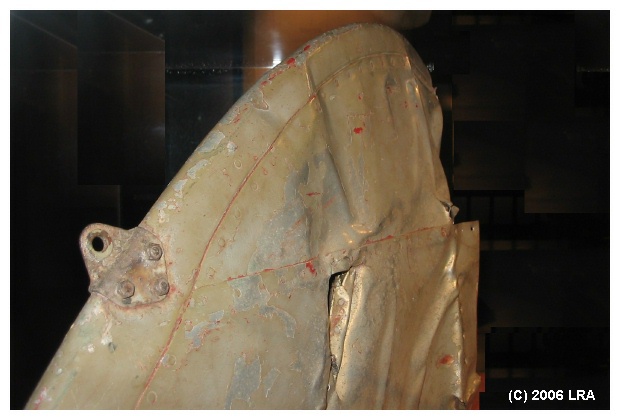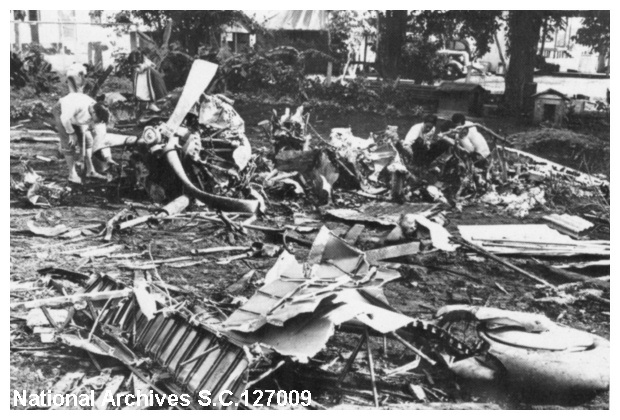by James Lansdale
Introduction
No less than fifteen Aichi Type 99 Carrier Dive Bombers (Kanbaku)
were lost during the attack on Pearl Harbor 7 December 1941. One kanbaku
was lost at sea on its return to the aircraft carrier SHOKAKU following
the first attack wave. During the second attack wave, most, if not all,
of the fourteen kanbaku were lost to anti-aircraft fire or defending
U.S. Army pilots. The aircraft carrier AKAGI lost four, KAGA losses were
six, while SORYU and HIRYU lost two each. Four or five kanbaku came down
in the waters and general area around FORD ISLAND. In the AIEA HEIGHTS
region, one kanbaku came down in a macadamia nut grove in the KALAUANO
Valley and the another in a nearby sugarcane field. At least two
more crashed and burned in the more populated area of WAHIAWA; one behind
the WAHIAWA Courthouse close to the Hawaiian Electric Company plant and
the other lay shattered at 711 Neal Avenue. One kanbaku crashed and burned
in the Kiawe tree scrub near the EWA Marine Corps Air Station (perhaps
the one reported as having come down SW of Fort BARRETTE?). In the BARBERS
Point area, one reportedly crashed 200 yards off Camp MALAKOLE (home of
the 251st C.A.C. Regiment), another was reported down in the surf or on
the beach and may have gone down further out to sea SW of the BARBERS Point
lighthouse. Some of these reports may be duplicate claims. Finally,
one was also claimed to have been shot down off KAENA POINT at the northwest
tip of OAHU.
Today, the remains or relics from at least six of the downed kanbaku may
be found in various museums and private collections. Unfortunately,
the provenance for most of kanbaku artifacts is often incomplete, sketchy,
or, at worst, erroneous. For several kanbaku relics the chain of custody
could not be established, or had been broken, or nonexistent. The
following report contains additional information for some of the Pearl
Harbor attack kanbaku artifacts to be found in various collections. The
focus will be to state all that was known at the time of this investigation
about each artifact as reported and an attempt to correct known errors.
Kanbaku artifact (USAR 1021) in the ARIZONA Memorial Collection was the subject of Part 2 and 3 in the series “Pearl Harbor Japanese Aircraft Crash Sites, Records, & Artifacts.” Its provenance is self-evident, for it bears the factory-applied stencil, “Type 99 KAN BAKU, AI CHI No.3217.” The chain of custody for USAR 1021 is well documented. Pat BETER of Waipahu, OAHU, had found this Pearl Harbor artifact on the beach at BARBERS POINT after hurricane INIKI struck the island in September 1992. Three months later, Mr. BETER turned the custody of USAR 1021 over to the jurisdiction of the ARIZONA Memorial.
Artifacts from the kanbaku crash sites in the AIEA Heights and WAHIAWA areas are dispersed in several collections; two are in the U.S. Army Museum of Hawaii (Fort DeRUSSY) in Honolulu; several are in the John EGGER and Todd PEDERSON Collection; and one fragment is on display in the Virginia Military Institute (VMI) Museum, Lexington, Virginia. Main or parts data-plates (s/nos 3133, 3141, 3183, and 3186) from these crash sites may also be found in private collections or museums including the WARNER ROBINS Museum of Aviation in Warner Robins, Georgia.

There are two kanbaku artifacts on display at the Fort DeRUSSY Museum. One is a parts data plate (HAW 2234), with the serial number “3186,” shown above. This relic has been on display since December 1988 and was originally cataloged by Glenn L. KOONS in 1982. The donor, “GLM, Jr.,” since deceased, stated he had personally recovered this piece from a Japanese aircraft that crashed in the “Kalauao Valley, Oahu, on 7 December 1941.” Todd A. PEDERSON has examined other artifacts from this crash scene and provided the following three photographs. These illustrate the remains as examined by Sam TOONEY (left), Ken CARNEY (right), and some local sugarcane field workers.



The second Fort DeRUSSY Museum artifact is a two by three foot fragment from an Aichi Type 99 Kanbaku horizontal stabilizer (HAW 2609 changed to HAW 535). It has been on display since 1989 and was also cataloged by Glenn KOONS. This kanbaku artifact is here illustrated below.

The provenance of this artifact, HAW 2609/535, is problematic. Unfortunately, as one may see above, this relic has been captioned as being the “Horizontal Stabilizer section from one of five ‘Kate’ bombers shot down in the raid.” By comparing the actual relic to a detail drawing of a Type 99 Model 11 Kanbaku horizontal stabilizer a positive identification is possible.


The Fort DeRUSSY Museum director and the curator were both surprised that the display bore an incorrect label since the museum property catalog clearly states that “most likely this is a tan horizontal stabilizer piece … from a Val dive bomber.”
The chain of custody of the two Fort DeRUSSY Museum artifacts is convoluted and muddled. The catalog number and information have changed. The documents do support the fact that the same individual did not recover the two pieces of kanbaku that are on display (i.e. the parts data plate with the Aichi s/n3186 and the horizontal stabilizer fragment). The curator, Judith A. BOWMAN, produced a record of the museum property catalog which stated that (HAW 2609/535) had been a piece “recovered from a Val dive bomber which crashed at Wahiawa Power Station on 7th December, 1941.”
The present condition of this artifact does not support this contention.
When the two kanbaku crashed in the WAHIAWA area the events were recorded in the HONOLULU STAR-BULLETIN (HS-B), U.S. Army Signal Corps photography and reports by investigative teams. The HSB article describes the WAHIAWA sites as follows:
“Some enemy planes were reported shot down. The body of the pilot was seen in a plane burning at Wahiawa. … At 9:34 a.m. a Japanese plane was reported shot down at Wahiawa. … At least two Japanese planes were reported at Hawaiian Department headquarters to have been shot down; one of the planes was shot down at Ft. Kamehameha and the other in back of the Wahiawa courthouse. … It was reported that an airplane (nationality undisclosed) crashed near the Hawaiian Electric Co. plant at Wahiawa. It was destroyed by fire, as were two houses near which it fell. The army and police flung a guarding cordon around the location and civilians were kept at a distance.”

U.S. Army Signal Corps photographs of the crash scenes (see example above) reveal that these two kanbaku were smashed to small fragments and charred by the resulting fires. As stated previously, one kanbaku crashed near the Hawaiian Electric Company power station and the other crashed at 711 Neal Avenue. The Fort DeRUSSY Museum kanbaku artifact HAW 2609/535 shows no evidence of any blistering or fire of either crash scene, however, it does show evidence of having been recovered from a crash site significantly differing from those described above.

It appears that the Fort DeRUSSY kanbaku tail fragment was not recovered at the time of the crash but lay buried below the ground surface for a long period of time before its presentation to the Fort DeRUSSY Museum. It is more likely this artifact was from the second of the two crash sites located in the AIEA HEIGHTS region, probably the one in the sugarcane field. One report states that several artifacts were recovered from this site after the end of the war. In addition to the damage sustained by the initial crash, the external skin of artifact HAW 2609/535 appear to have been crushed and compacted by the weight of the earth. Perhaps this piece was long forgotten after having been covered by earth at the time of the crash or simply plowed under. Although the external surfaces appear to have been cleaned for some time prior to its display, the interior surfaces still retain traces of reddish-brown silt clay characteristic of the soils that developed from the lava fields of the KOOLAU Mountains. This unique soil is geologically known as "Wahiawa Soil" and is found predominantly on acreage used for the growing of sugarcane or pineapple.


The internal surfaces are coated with aotake and some of these areas have been over-painted with black paint. The external surfaces are natural metal, with a layer of gloss red paint close to JPMA 2005 C 05-40V (Munsell 5R 4/12). There was no evidence of a primer coat over the metal. This would appear to provide evidence that this kanbaku had previously been in a “red-tail” livery. The external finish was, as previously stated, weathered. Some chalking does appear in spots, however, the predominate colors range from JPMA 2005 C 25-50D (Munsell 5Y 5/2) to C 25-60D (Munsell 5Y 6/2) which are slight variations of the ranges previously seen in the Federal Standards 595B olive/khaki-grays FS-24201/16350/16160.
Another artifact from a Pearl Harbor attack aircraft is on display at the Virginia Military Institute (VMI) Museum in Lexington, Virginia. The fragment of aircraft skin, is known as “VMI 44-448” or accession number 1944.0448. It measures 20.7 cm in length by 11.5 cm at its maximum width (approximately 8 1/8” x 4 5/8”). Its provenance would appear to be self-evident. On the interior surface, scratched into the aotake paint, is the inscription: “PART OF JAP PLANE SHOT DOWN AT KANEOHE NAVAL AIR STATION, OAHU, T.H 12/7/41.”


The only documented Japanese aircraft, known to have crashed at KANEOHE Naval Air Station (NAS) on 7 December 1941, was the Mitsubishi Reisen flown by SORYU pilot Lt. Fusata IIDA. Therefore, the initial identification of the relic, VMI 44-448, was that it was a fragment souvenired from the IIDA Reisen.
Retired Senior Curator for Aeronautics at the National Air and Space Museum (NASM), Robert C. MIKESH conducted a forensic color examination of the VMI 44-448 in June 1997. In a report dated June 17, 1997, MIKESH presented his finding based on both visual and colorimetric analyses of the VMI relic.

The piece (shown in detail above) was devoid of any primer paint to bind the exterior paint coat to the metal. The exterior paint coat was extensively chipped and varied in color. A clear coat of some preservative material had been applied to alleviate further chipping. Later investigation demonstrated that this material was actually the remnants of a clear tape initially used to attach the relic to a display board. The accuracy of the MIKESH readings was affected by the “beading of clear coat which has turned orange in areas.” All color readings made were compared to the Munsell Color System. The colorimetric readings for the exterior paint included areas which gave readings of Munsell 2.5Y 4.5/2.7 (visually close to JPMA 2005 C 22-50D/Munsell 2.5Y 5/2). The readings varied in other places to an extremely dark value of Munsell 8.5YR 4.4/3.0 (visually close to JPMA 2005 C 17-40H/Munsell 7.5YR 4/4). A Federal Standard 595B color average would be close to FS-16160 and darker. The interior surface was a translucent aotake yellow-green with darkened areas that were almost black. The stringer was black.
When the color data produced by the MIKESH analysis of the VMI 44-448 relic was compared to the color data produced by the color analyses of known IIDA Reisen samples in four other collections, it was apparent that the VMI relic did not match any of the characteristics shared in common by the other IIDA Reisen relics.
1. All other IIDA Reisen aircraft skin relics had a coppery/red-oxide binder paint layer between the exterior coat of paint and the metal.
2. The exterior paint color of all other IIDA Reisen skin samples were close to JPMA C 27-50D/Munsell 7.5Y 5/2 (i.e. decidedly more of an “olive-green” than the “khaki-tan” shades found on the VMI 44-448 relic).
3. The translucent aotake paint used on the interior of all other IIDA Reisen aircraft skin samples were a “brilliant blue” color, while the aotake found on the VMI relic was more of a “yellow-green.”
Perhaps the most compelling evidence that VMI 44-448 had a different provenance than the other IIDA Reisen relics was the presence of the reddish-clay silt or oxisol of the "Wahiawa Soil" type still clinging to the surface around the rivets and along the stringer on the interior surface (see below). This type of soil is not at all characteristic of the beach sands found in the KANEOHE Bay region where the IIDA Reisen crashed.

VMI artifact 44-448 was re-examined 16 January 2007 by VMI Museum Director, Col. Keith E. GIBSON. Col. GIBSON reconfirmed the presence of the “Wahiawa Soil” still to be found on the reverse surface. Col. GIBSON also provided additional information on a related artifact from the same crash scene that had been presented by the same donor to VMI in 1944. This artifact is “VMI 44-447,” or VMI accession number 1944.0447 and is shown in the following photographs.


Utilizing the information provided by the donor, Cadet George V. GELLY, VMI Class of 1947, VMI 44-447 is listed in the VMI records as follows:
“Airplane Fragment
Description
Part (fuel or hydraulic system) of a Japanese torpedo [sic] plane which crashed on the heights above Pearl Harbor Naval Station 7 December 1941. The plane burned, killing both pilot and gunner. Piece was picked up on the scene by Cadet George V. Gelly, VMI 1947, and presented by him to the museum in March, 1944.”
The foregoing circumstantial evidence leads this writer to conclude that it is very probable that both VMI 44-447 and 44-448 artifacts are from an Aichi Type 99 Kanbaku that crashed in the AIEA Heights region of Oahu, an area that is characterized by the "Wahiawa Soil" type (shown below in this view from the sugarcane fields looking west/southwest 7 December 1941).

The foregoing circumstantial evidence leads this writer to conclude that it is very probable that both VMI 44-447 and 44-448 artifacts are from an Aichi Type 99 Kanbaku that crashed in the AIEA Heights region of Oahu, an area that is characterized by the "Wahiawa Soil" type. It is also equally certain that relic VMI 44-448 is not from the IIDA Reisen remains which crashed at KANEOHE Bay in spite of the inscription which it bears.
Jim Lansdale
[Part 1] [Part 2] [Part 3] [Part 4] [Part 5] [Part 6] [Part 7]
Credits: Todd A. Pederson; National Archives/S.C.127009-127099; The Honolulu Star-Bulletin, 7 December 1941; Arizona Memorial; Gail Fuller, Director, and Judith A. Bowman, Curator, U.S. Army Museum of Hawaii; Robert C. Mikesh, Senior Curator for Aeronautics, NASM (Retired); and Colonel Keith E. Gibson (Director) and Barbara J. Blakey (Records Custodian), Virginia Military Institute Museum.
Documents:
“Information On Japanese Aircraft,” J.E. Shoemaker, U.S.NAS Pearl Harbor, T.H.: December 18, 1941.
Memorandum: Summary “Report of Planes Shot Down, Crashed, or Destroyed In the Attack on Oahu, 7 December 1941” to Lt. Col. Kendall J. Fielder; c/c G-2, Hawaiian Air Force, Hickam Field, T.H., December 1941.